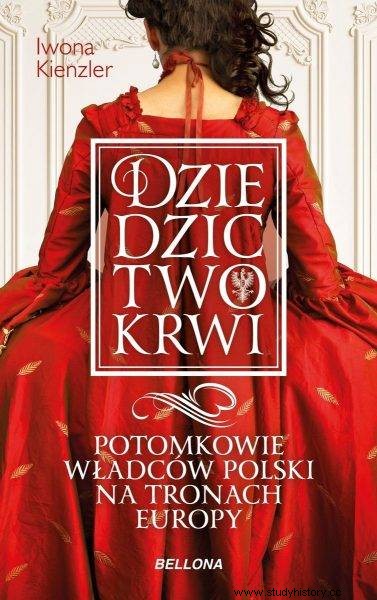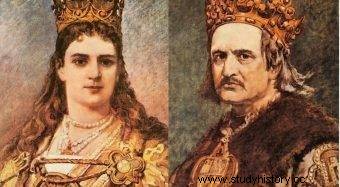Jadwiga Andegaweńska was crowned King of Poland on October 16, 1384. However, the Polish throne almost passed her nose close to her - and more than once. Originally, it was not supposed to rule over the Vistula, but in the end - as they say - art up to three times ...
It was known from the beginning that after Ludwik Węgierski the girl would get the crown. His first wife, Małgorzata Luksemburska, died at the age of 14, so she did not manage to give him a successor, and the second - Elżbieta Bośniaczka - gave birth to only daughters. And there are four:Maria (died in infancy), Katarzyna, another Maria and Jadwiga.
The king, however, was determined to keep the crowns of Hungary and Poland "to the family." This was less of a problem in his native country, as Hungarian law allowed for distaff to be inherited. It was out of the question on the Vistula River. At least officially.
Privilege of Košice - if not goodness, then ... bribery
To make matters worse, the Polish nobility was not very favorable to the Hungarian king. In Greater Poland, a plan was even born of a coup and placing on the throne of Kazimierz the Great's grandson, Kaźek Słupski, but the plot ended in vain, and Ludwik managed - literally - to win the favors of the Vistula lords.
In 1374, during a convention in Košice (then in Upper Hungary), Anjou gave the Polish nobility the first royal privilege, which went down in history as a Košice privilege.
It established, inter alia, one permanent tax for all, in the amount of two groszy from a peasant's land. By the way, it was the basis of the Polish nobility. Prof. Maria Koczerska reports:
In return for granting new rights to the nobility, as well as for limiting his own fiscal rights and more, the king was assured that after his death, his daughter would take the Polish throne . What is important - it has not been specified which one. It was Ludwik and Elżbieta Bośniaczka who were to decide about it.
And they did not decide that it would be Jadwiga.
The best party in Europe
How did it happen that ultimately it was the youngest of the daughters of Ludwik Węgierski and Elżbieta Bośniaczka, who sat on the Polish throne? Prof. Maria Koczerska explains:
Katarzyna, Maria and Jadwiga were among the best parties in Europe, therefore the king of Hungary could negotiate marriages with the greatest dynasties. In the original plans, the eldest Catherine was to marry Louis of Orleans, son of King Charles V of France.
Ludwik hoped that maybe with the help of the Valencians he would be able to gain the throne in Naples for this couple. But her reign in Poland was also at stake, because in 1374 in Košice the king forced the mighty to swear allegiance to Catherine.

The text was created, among others based on the book by Iwona Kienzler “Blood heritage. Descendants of Polish kings on the thrones of Europe ”, which has just been released by the Bellona publishing house.
The middle daughter, Maria, was to become the wife of Sigismund of Luxemburg, son of the Emperor and Czech ruler Charles IV. An appropriate arrangement was made when the future bride was only two years old, and the chosen one - five.
Ludwik Węgierski chose the Austrian prince William of Habsburg as the husband for Jadwiga born in 1373 or 1374. The symbolic wedding of the couple took place soon after - in June 1378 in Hainburg. However, for the ceremony to be valid, it was necessary for the spouses to consummate the relationship - which was to happen when Jadwiga "reaches smooth years".
Maria Andegaweńska, Queen of Poland
In the same year, things started to get complicated. Iwona Kienzler in her latest book, "Blood Heritage. Descendants of Poland's kings on the thrones of Europe ”describes:
Louis' eldest daughter unexpectedly died in 1378, which forced his despairing father to change his succession plans. Maria became the heir to the throne in Poland, and the youngest Jadwiga was to receive the crown of Saint Stephen and reign in Hungary in the future.
Interestingly, if the plan of the Hungarian monarch were successful, the royal couple with Polish roots would sit on the Polish throne. Iwona Kienzler emphasizes:"Polish, Piast blood was flowing in the veins of both the prince and his future wife. Karol's son was the great-grandson of Casimir the Great, and Maria was his great-aunt because the grandmother of the Hungarian princess on her paternal side was the full sister of the last king of Poland from the Piast dynasty ".
By the way, because of their - there was not - quite close kinship, Maria and Sigismund had to receive a papal dispensation, which in 1374 was granted to them by the then father Saint Gregory XI.
In July 1382, the ailing Ludwik forced the Polish starosts to pay homage to Maria and Zygmunt. Less than two months later, on September 10, 1382, the king died, and there was an interregnum in Poland. Elżbieta Bośniaczka did not intend to respect her husband's will and five days after his death she led Maria to be crowned king of Hungary.
Jadwiga who wanted a German
The throne in Krakow remained empty for the next two years not only because of the Bosnian decision to grant Maria power in Hungary. The Polish nobility did not like the fact that Angawenka, destined to be the ruler of the country, was the wife of a Luxemburger. Anyway, as it soon turned out, they also looked wickedly at Wilhelm Habsburg as Jadwiga's possible husband.
Because it was she - as agreed during the convention in Košice - who remained as the last potential candidate for the Polish crown. Prof. Maria Koczerska comments:
Recognition of the reign of one of his daughters - Maria married to Sigismund of Luxemburg or Jadwiga destined to Wilhelm Habsburg - threatened to include Poland in the conglomerate of Luxembourg or Habsburg states and lands. Poles have chosen the path of independence. They decided to choose a candidate for a husband for Jadwiga.

Władysław Jagiełło appeared on the historical scene, but that is a completely different story.
In this way, they respected their obligations towards Ludwik Węgierski, and at the same time got their way. Władysław Jagiełło appeared on the historical scene, but that is a completely different story.
Bibliography:
- I. Kienzler, The Legacy of Blood. Descendants of Poland's kings on the thrones of Europe , Bellona 2021.
- J. Krzyżaniakowa, Jadwiga - Queen of Poland 1384–1399 , "Lithuania", 2 (11) -3 (12), 1994.
- M. Maciorowski, B. Maciejewska, Rulers of Poland. History re-told , Agora 2018.
- J. Wyrozumski, Queen Jadwiga. Between the Piast and Jagiellonian eras , Universitas 2006.
